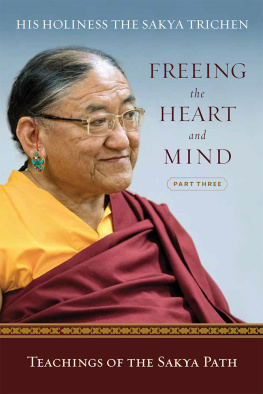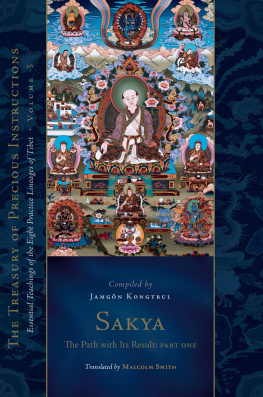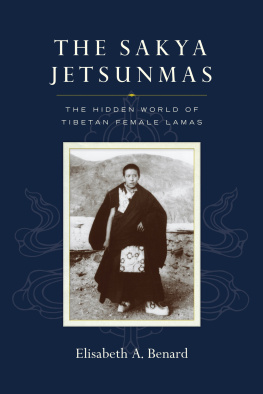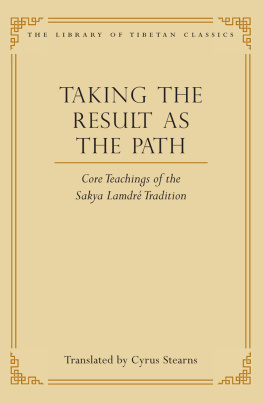About the Author
HIS HOLINESS THE SAKYA TRICHEN is the forty-first head of the Sakya order of Tibetan Buddhism and a member of Tibets noble Khon family. He is also a descendant of the five great masters who founded the Sakya order in the eleventh and twelfth centuries.
Just as His Holiness the Dalai Lama is an emanation of Avalokiteshvara, the manifestation of all the Buddhas great compassion, His Holiness the Sakya Trichen is the emanation of Manjushri, the manifestation of all the Buddhas transcendent wisdom.
After political changes in 1959 forced many Tibetan Buddhist leaders to leave Tibet, His Holiness reestablished the headquarters of the Sakya order in northern India. Overcoming all difficulties, he reestablished monasteries, nunneries, and colleges in India and Nepal and worked to restore the original institutions in Tibet. In short, within sixty years he accomplished not only the reestablishment of hundreds of religious institutions that had been the work of many generations of previous masters, but their expansion into new lands.
In addition to reestablishment of the Sakya orders core religious institutions and teachings, His Holiness ensured the next generation of lineage holders in the person of his highly trained and realized sons, Ratna Vajra Sakya and Gyana Vajra Sakya, who serve as the forty-second and forty-third Sakya Trizins.
During the 1970s, His Holiness began to establish Sakya centers in various countries of the world, with hundreds of centers under his guidance in the Americas, Europe, and Southeast Asia. In 2000, His Holiness established Tsechen Kunchab Ling, in Walden, New York, as his monastic seat in the Americas.
His Holiness is the peerless guide and leader of hundreds of thousands of monks, nuns, and lay students in Tibet, India, Nepal, Southeast Asia, Australia, Europe, and North America. From his main seat in Rajpur, India, he travels tirelessly throughout the world to direct the work of the temples and centers, to fulfill requests for teachings, and to benefit beings.
LUMINOUS WISDOM DIRECTLY FROM HIS HOLINESS THE SAKYA TRICHEN.
Collected from teachings by His Holiness, this book is a warm and comprehensive introduction to the Buddhist path as told by the patriarch of the Sakya order. His Holiness offers explanations of the philosophical tenets of the Mahayana path and in particular the Sakya school of Tibetan Buddhism giving down-to-earth advice for practicing in the world today, including
the principles of tantra,
the value of retreat,
the history of the Sakya lineage,
ecology from a Buddhist perspective,
biographies of great women practitioners,
and other fascinating topics.
This is a must-read for anyone interested in following a Buddhist spiritual path.
HIS HOLINESS THE SAKYA TRICHEN is the revered forty-first throneholder of the Sakya school of Tibetan Buddhism, in a long line of great masters that dates back to 1073. A brilliant master, he manifests profound wisdom and compassion, and his command of English renders his teachings particularly beneficial to students in the West. In 1959 he relocated with tens of thousands of Tibetan people to India, where he continues to live and work tirelessly to rebuild the Sakya tradition.
Join Wisdoms mailing list and find out what to read next!
Receive the latest news and updates from Wisdom, including new releases and special offers.
Click here to sign up.

1. The Four Noble Truths
IN THIS WORLD, there are many different places, cultures, philosophies, religions, and traditions. But one thing common to all of them is that everybody wants to be free from suffering. In other words, everybody wishes to have happiness. Every individual is making efforts in their community and every country is making efforts in the world toward this goal.
But it is very clear that until we have made spiritual progress, we cannot actually gain the happiness we are seeking, no matter how much external effort we put forth or how much progress we make. Although the fundamental goal is to achieve happiness, every external goal, unless it is linked to inner mental development, will in fact bring more misery and suffering instead of bringing more happiness. Therefore, everyones goal of true happiness has to come through inner spiritual development. It is only through spiritual practices that we can achieve happiness.
There are many great masters who came into this world and gave many different types of teachings. Each teaching has its own beauty, its own ways to solve problems, and its own path to find inner peace and happiness. But what I will discuss is the path according to the Lord Buddha kyamuni.
For three countless eons, the Buddha worked to accumulate tremendous amounts of merit and wisdom for the benefit of sentient beings. Through that accumulation of merit and wisdom, he eventually overcame all obscurations and defilements. Everything that needed to be parted from was parted from and every possible good quality that needed to be gained was gained.
The Buddha is fully awakened, fully enlightened, and has the power to help sentient beings free themselves from suffering. Even one ray of light from his body or one line of his teaching can help countless sentient beings in a single moment. Directly or indirectly, any contact with the Buddha will help to release one from suffering and gain happiness.
From the beginning, the Buddhas whole purpose was to help all sentient beings without any exception. Every activity that he performed was for the benefit of sentient beings. He performed many great physical activities, verbal activities, and mental activities. But among these, the most important were his verbal activities: the teachings he gave about what he had realized. This is called turning the wheel of Dharma. Through these teachings, the Buddha helps sentient beings. Those who are not ripe are ripened, those who are not on the path are placed on the path, those who are not making progress become able to make progress, and those who are already making progress are helped to gain higher realization.
Sentient beings have no limit they are countless, just as space is limitless. These limitless sentient beings are all different their mentalities, their defilements, their mental conditions, their propensities are all different. Therefore, one type of teaching cannot help all sentient beings. Just as there are different types of medicines and treatments in order to cure different types of diseases, the Buddha gave an enormous number of teachings in order to suit every type of sentient being. So the teachings of the Buddha have many different levels, according to the followers mental states and conditions, situations, environments, and so forth.
In this chapter we are going to focus on what is known as the first turning of the wheel of Dharma. This teaching occurred after the Buddha attained enlightenment at Sarnath (Deer Park). The subject of that first teaching is the four noble truths. The four noble truths include both the cause and result of sasra, and the cause and result of nirva. The four noble truths are (1) the truth of suffering, (2) the truth of the cause of suffering, (3) the truth of cessation, and (4) the truth of the path. One must know the truth of suffering, abstain from the cause of suffering, realize the truth of cessation, and practice the truth of the path.
THE TRUTH OF SUFFERING
First, one should know the truth of suffering. If we are sick with a specific disease, the first thing we must do is to learn the exact nature of the sickness. Otherwise, we cannot determine any treatments. Similarly, to have an effective treatment for suffering, one must know the exact nature of suffering. In order to give rise to genuine renunciation thought, which is the sincere wish to practice and enter the path in order to gain liberation, we must know the truth of suffering, what suffering is, and the exact nature of suffering.









